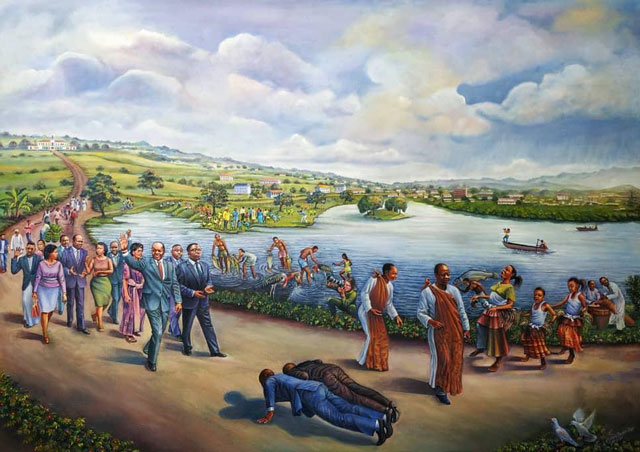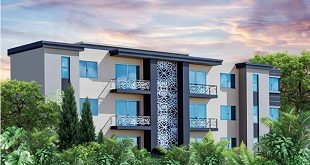
The artist figuratively explores and interrogates the subject of peace tranquility in the Monarchy
Kamapala, Uganda | DOMINIC MUWANGUZI | Buganda is the largest Kingdom in Uganda occupying vast territory across the country. Since the precolonial times, the monarchy has hosted several groups of people including Arab traders, European explorers and later missionaries. This was coupled with the different tribal groups like Batooro, Banyoro and Banyankole who often were integrated in the Buganda society. In this, Buganda from the earliest days, was described as a heterogeneous society where every group, irrespective of its background lived freely and happily.
In the present day, the Kingdom has continued to manifest this harmonious trait by hosting a diversity of racial and ethnic groups including Indians, Somalis, Eritreans, Congolese, Rwandese and Sudanese. The areas of Mengo- Kisenyi, Kansanga- Bbunga, Kalerwe-Bwaise and several outskirts of Kampala are predominantly occupied by these groups.They live together with the indigenous people without any encounter of segregation or confrontation.
The painting Buganda Kingdom 2021 by Prof. Francis. X. Ifee is figurative interrogation to the concept of peace and tranquility which prevails across the Kingdom. The painting also examines the subject of harmonious living that underlies the above subject. This is in spite of the diverse social, political, cultural and economic wellbeing of the inhabitants.
Naturally because of its location, Buganda is the epicentre to many political parties’ activities, an amalgamationof thepoor and rich and amelting pot of diverse cultures. Such sharp contrasts in one space, one may be prompted to conclude, can perpetuate rampant social injustices. However, such is the reverse, where the Kabaka often implores his subjects to seek for peace and reconciliation; even during the aftermath of a heated political contest.
The artist’s choice to set the painting at a local beach is a representation of freedom, peace and tranquility he wishes to explore.
The scenery of Kabaka’s Lake in Ndeeba or Kayanja ka Kabaka as it is popularly known by locals, is recurrent in several of the artist’s previous paintings. He uses it as a metaphorical representation to the subject of freedom where he metaphorically alludes to the site as an ideal place where anyone is free to do anything they want. In this particular painting, he delves more into the subject, juxtaposing it with social-political, cultural and economic wellbeing of the citizens.
Interestingly, these aspects of everyday life, seeminglypromote co-existence between the people at the beach. This underscores one of the core principles of Buganda which is togetherness- Obuumu. In the painting, one observes people belonging to different political orientations -represented by a range of political colours of yellow, red, green and orange-sharing the same space and even shaking hands!
The composition of his entourage re-emphasizes his liberal character. Right besides him is the Katikiro,Peter Charles Mayiga who according to Buganda culture is the connection between the subjects and the Kabaka. He is an ordinary figure with no royal background. This is symbolic to the ideal of inclusiveness where everyone iswelcome to serve and contribute to the Kingdom. This inclusivity is further highlighted in the varied number of seasoned politicians and government technocrats who are accompanying the Kabaka on this momentous occasion. Here, it is evident that the monarch has no political affiliations and is therefore a symbol of unity.
The middle ground of the painting suggests plenty of activity going on in the water and on the shores. A typical scene on the Lake involves fishing in canoes, swimming by the youth and sometimes beach parties. In the painting, the artist depicts a lot of fish being caught as a sign of abundant food for the different groups of people who inhabit the Kingdom.
Naturally, a land that has plenty of food attracts many people. Similarly, Buganda’s ability to attract a diversity of people is not only inspired by its ancient cordial relationship with outsiders, but also necessitated by the enormous foodstuffs found across the Kingdom. There is certainly enough food in Buganda for everyone, including destitutes, who are fed freely. The latter group is figuratively represented by the Marabou Storks which are feasting on the fish with no disturbance from the fishermen.
The sprawling green vegetation in the background joins the rolling hills in the far distance to illustrate the rush vegetation which covers Buganda countryside. This depiction of rush vegetation contributes to the global narrative of environment conservation, especially in the contemporary times. Buganda Kingdom stance on environment conservation and sustainability can not be over emphasized here. On several occasions, the Kabaka has participated in environmental campaigns like Bulungi Bwansi, to demonstrate to his subjects the need to conserve the environment within which they live by planting trees and preserving the already existing flora and fauna.
The painting Buganda Kingdom 2021 is a visual representation of the identity of the Kingdom. In this, it espouses political, social and cultural connotations which give it an ambiguous and suggestive character. This is particularly the strength of painting for the viewer can draw a diversity of interpretations from the artwork, depending on either their personal relationship with the Kingdom or interaction with the citizenry.
The varied conclusions are critical in the formation of a better society which seeks peace and reconciliation especially during these times when social political and cultural differences seem to dominate many forums of debate across the country.
****
 The Independent Uganda: You get the Truth we Pay the Price
The Independent Uganda: You get the Truth we Pay the Price



